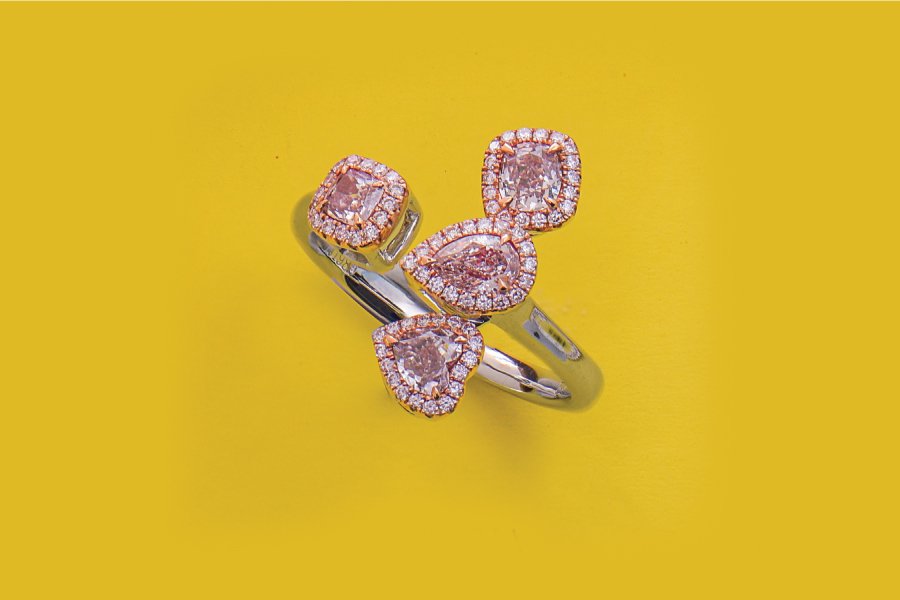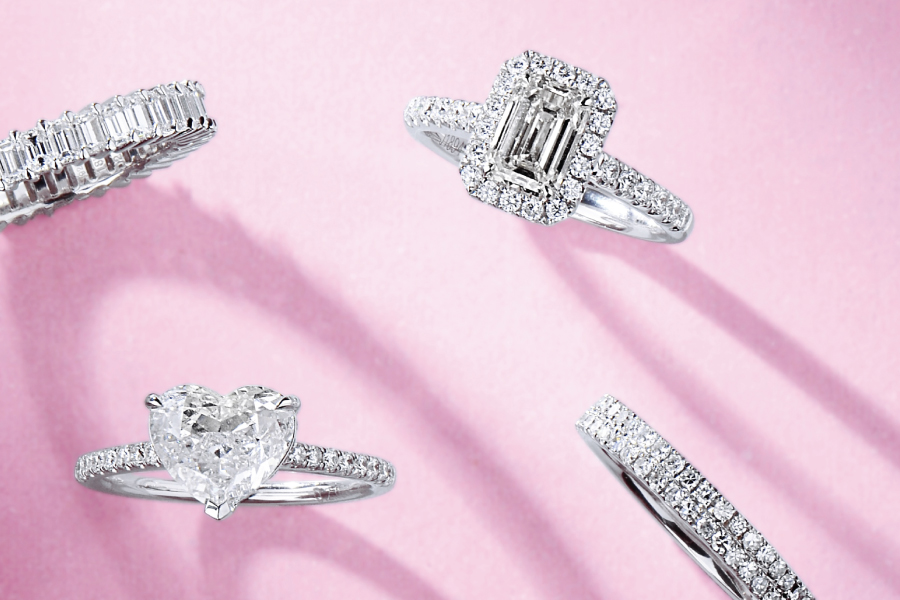All rings, including diamond engagement rings, come in a variety of settings. The "main two" settings have traditionally been prong and bezel.
Both settings are visually and materially distinct, and they serve quite different purposes. Some cuts, as well as differing diamond weights, are better suited to one or the other.
But what are the advantages – and disadvantages — of each?
Prong Setting Basics
The most popular type of ring setting is the prong setting. In its most basic version, it consists of four metal pins spaced evenly around the diamond, which act as a claw to hold the stone in place.
The 6-prong and Tiffany settings are two variations of the classic prong setting. The Tiffany setting features six prongs as well, but it is a Tiffany & Co. patented setting with differently shaped prongs. Rings with eight prongs are also popular.
Bezel Setting Basics
The bezel setting differs from the prong setting in a number of ways. A bezel is a single ring of metal that surrounds the complete circumference of the diamond, rather than using a claw-like mechanism to attach the stone. Typically, the metal is the same as the rest of the ring.
Prong Setting Pros
The purpose of a prong setting is to allow as much of the diamond to be visible as possible. The narrow prongs hide very little and allow maximum light to enter and exit the diamond. This results in more brightness and fire than the typical bezel setting allows for. The setting raises the diamond over the ring's shoulders, giving it an "elevated" appearance.
The majority of cut varieties will work in a prong setting, while cuts with sharp corners, such as square, emerald, or Asscher, are less common.
Cleaning a prong setting is also fairly simple. Dirt and grime have significantly fewer places to hide, and if they do attach themselves to the ring, they are much easier to remove.

A beautiful diamond ring
Bezel Setting Pros
In a bezel setting, the diamond is securely protected from potential damage by the metal ring that surrounds it. If the stone is struck, the ring is significantly more likely to carry the brunt of the blow, leaving the diamond unharmed.
A bezel is extremely secure, maybe the safest of all setting styles. The stone is firmly secured in place all of the time since the bezel is normally above the girdle of the diamond.
A bezel setting has a very clean and contemporary appearance. The enclosed circular form of the bezel also makes it less prone to damage.
Low-sitting rings (also known as low-profile rings) are usually bezel-set.
Prong Setting Cons
Despite its reputation, the prong setting is prone to damage due to its design. It also means because more of the diamond is exposed to impact, it requires greater caution to avoid chipping.
Prongs snag due to their nature and structure. Clothing poses a threat to a prong setting because of the potential for harm if snagged. It is not uncommon for stones to be misplaced without the wearer noticing until it is too late.
The prongs might also loosen over time. Again, this isn't often apparent until it's too late and the diamond has gone.
Bezel Setting Cons
It's a simple reality that in a bezel setting, you won't see as much of the diamond as you would in a prong setting. Less reflected light is sent back to the observer since more of the diamond lies below the bezel line.
Rings set in bezels appear to be a little bulkier than rings set on prongs. There is a noticeable decrease in overall slickness, offering a more substantial look.

Diamond rings
Bezel Setting Vs. Prong Setting: Which Should You Choose?
There is no “best” in this comparison, as there is in many others. The advantages of both prong and bezel settings clearly outnumber the disadvantages. Personal taste and the allure of the ring under consideration will be the deciding factors.
The uniqueness of these places is what makes them so appealing. This provides for a clear distinction between each stone's visual qualities, allowing the same stones to appear dramatically different in two different contexts.
If you plan to wear your ring all of the time, a bezel setting has a distinct advantage, solely in terms of security. A bezel set ring has a significantly lesser risk of a diamond being damaged or lost than a prong set ring.
But you have that gorgeous 5-carat diamond, and you want to flaunt it daintily, right?
You will need to be more careful of what you do while wearing the ring, but if you know that, a prong setting may be the perfect choice for you.
The only true piece of advice is to have a look at both options. Compare diamond engagement rings with comparable stones set in prong or bezel settings to determine which one appeals to you the best. It's like picking the puppy that comes running towards you. You'll just know which one is right for you.







